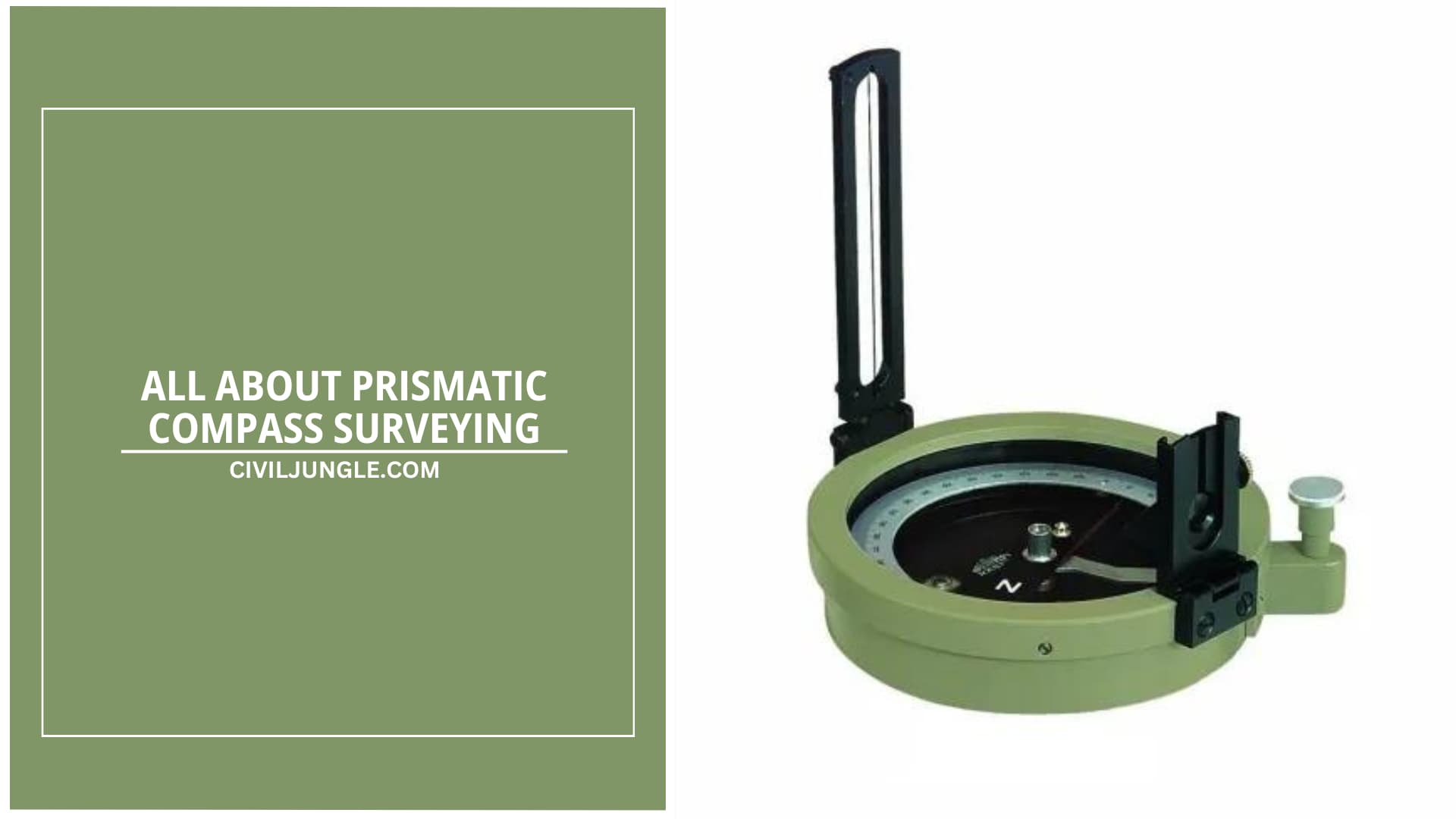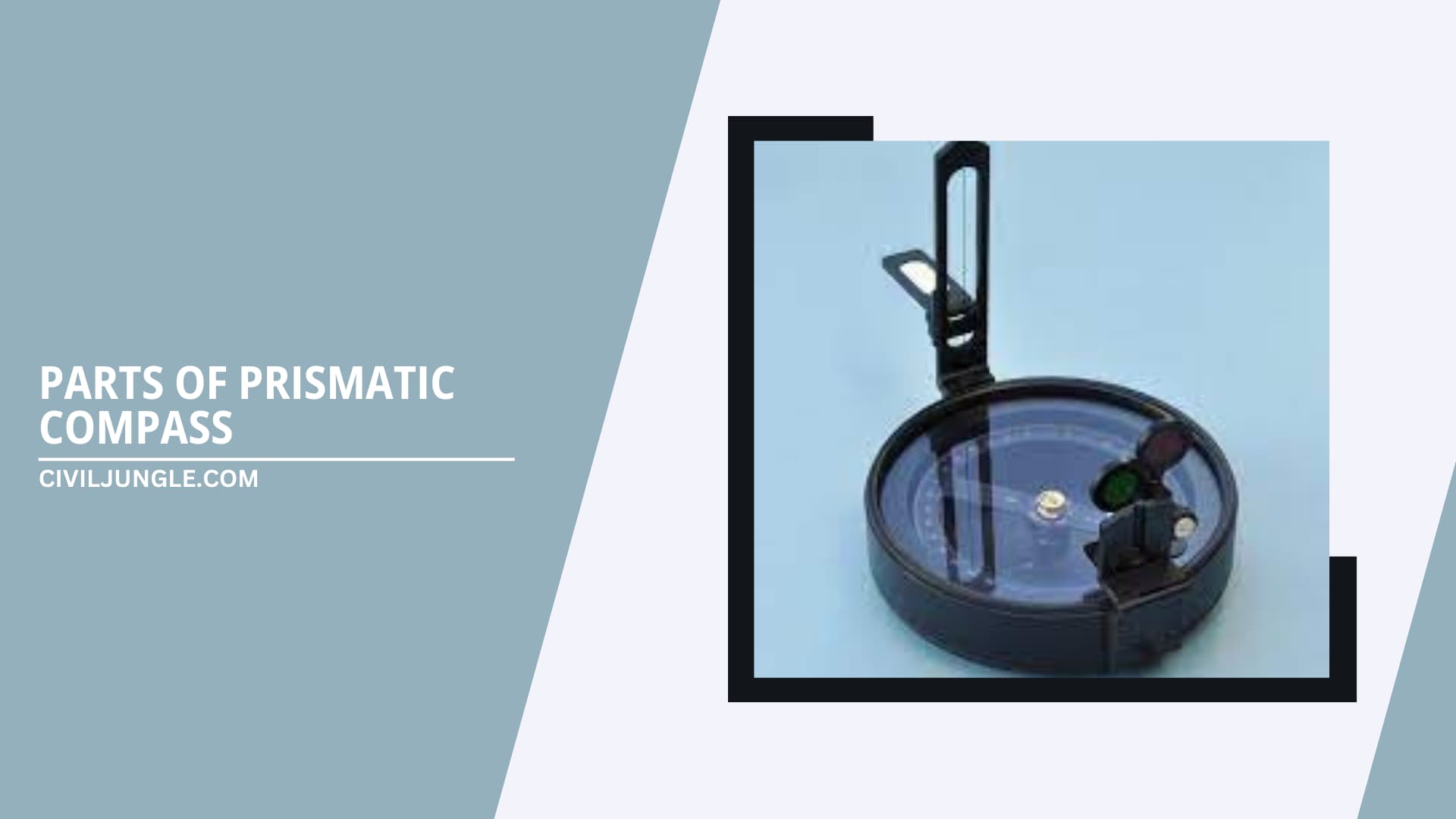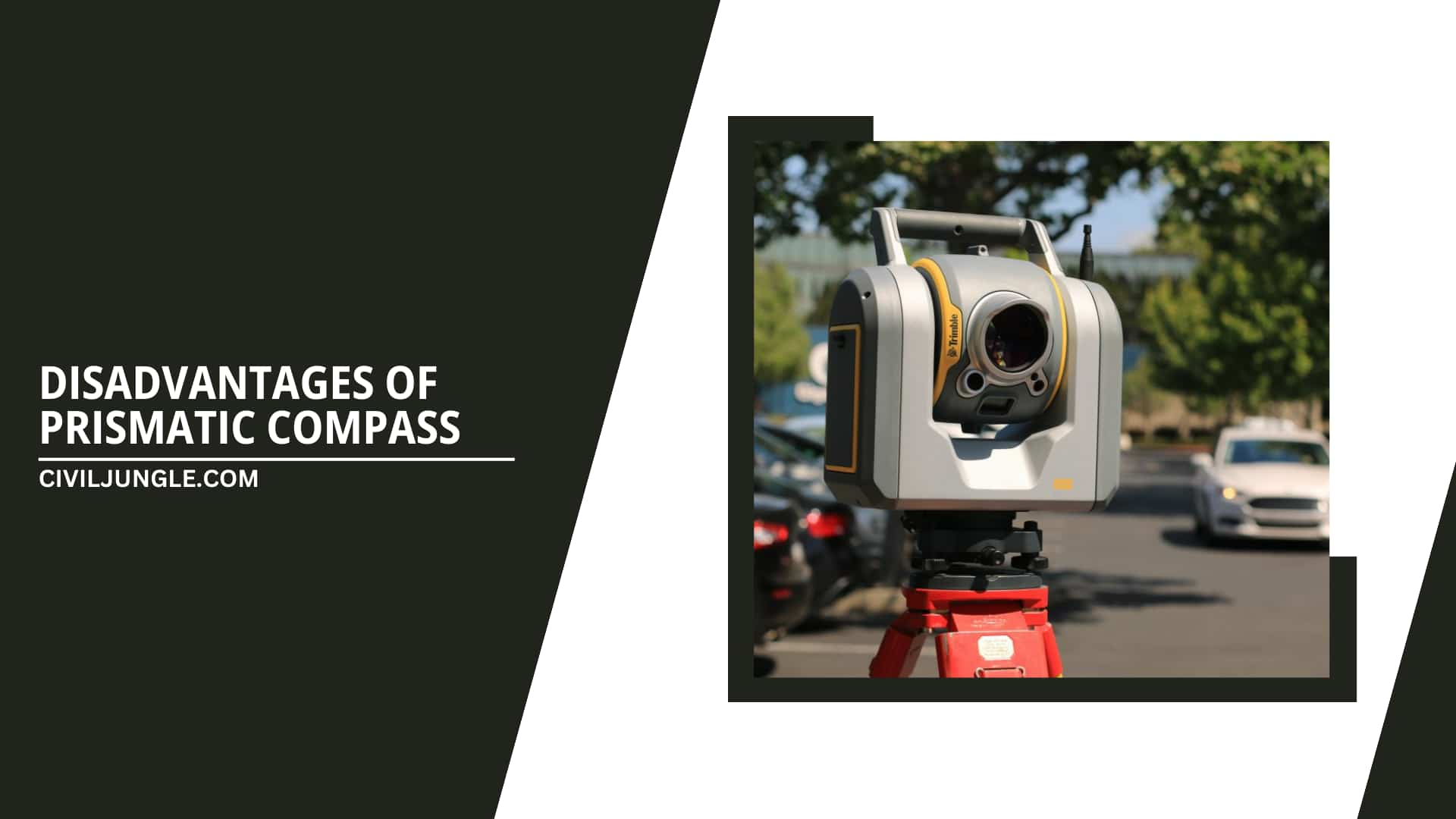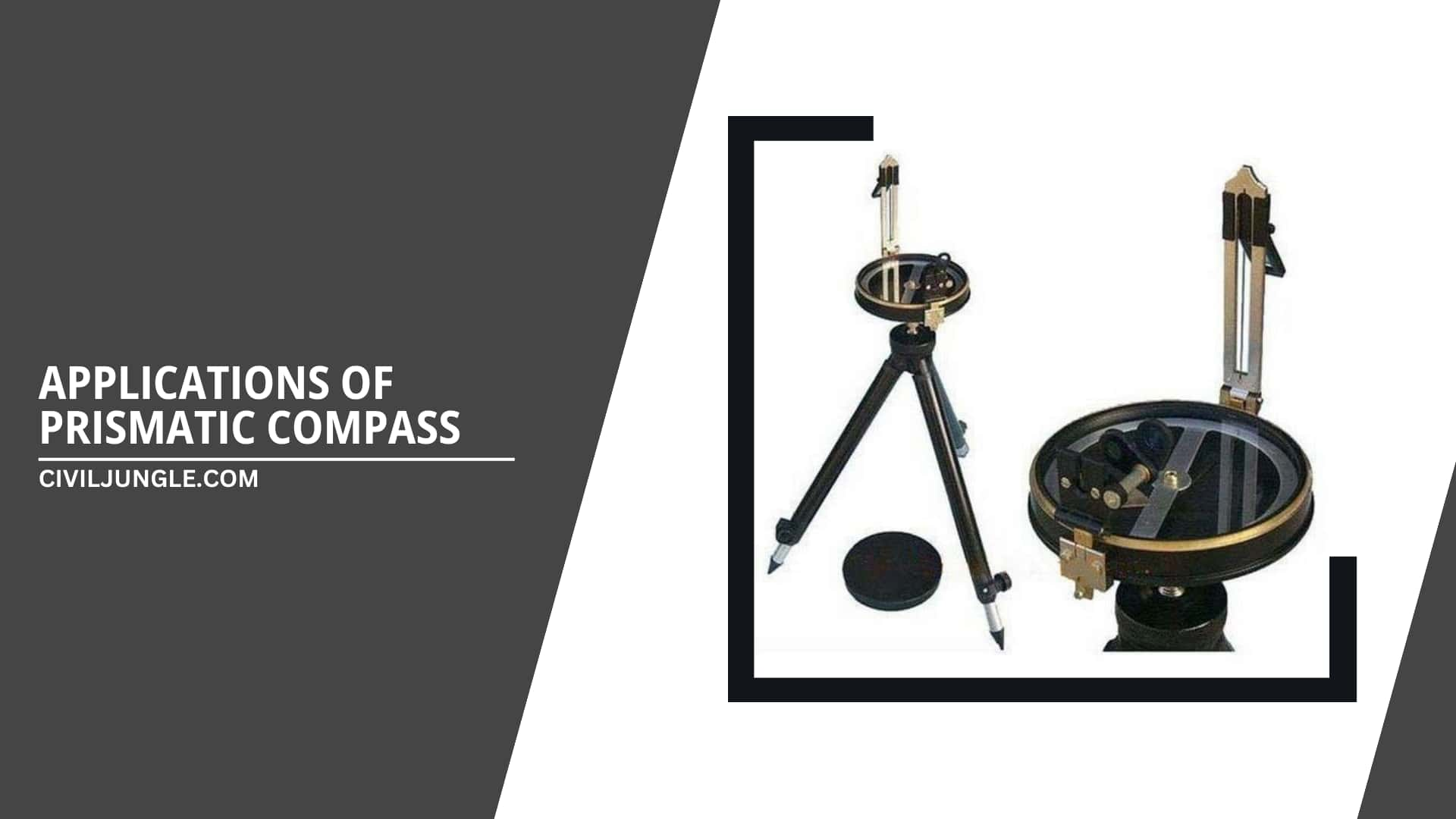What Is Prismatic Compass Surveying?
Important Point
What is prismatic compass surveying? It is the kind of prismatic compass survey used only to determine the angles identified as bearing as well as the range is determined by the measuring tape.
Often referred to as a prism compass, it’s essential for various surveying tasks.
Prismatic compass is compact and flexible, normally borne by hand.
This prismatic compass is among the two major types of magnetic compasses used in the series for the function of magnetic bearing measurement, the exception being the magnetic compass.
The circle is read as observing the conclusion of the graduation run clockwise from the south end of the needle.
The mirror located in front of the forward vane slides up and down the vane, folding flat over it, or resting inclined at any angle with it.
This mirror is used to see single objects or to view some very high object and is normally fitted to a compass.
The prismatic adapter consists of a 45-degree translucent prism with ice and a strongly convex reading mask to magnify the image of the graduation.
The prism is installed and can be rotated up and down between both the slides around the outside of the case.
The goal of this up and down movement is to have a concentration change.
The graduation image is seen through a small circular aperture in the prism mounting and immediately above this aperture is a small v cut on top of the mounting over which the vertical wire in the front aperture can be viewed.
The prismatic compass is mostly found in a compact instrument which would be kept in the hand for observation and is thus used in rougher working groups.
The graduated upon that prismatic compass is located on a lightweight aluminum ring affixed to the needle, as well as the graduation zero corresponds with the graduation point only at the south of the needle, which means that the needle stays stationary as well as the index is rotated with the sighting valves.
Also, Read: What Is Isometric Projection?
Parts of Prismatic Compass
- Cylindrical Metal Box: The cylindrical box, often depicted in a prismatic compass diagram, with a size of 8 to 12 cm covers the compass and then the whole casting or body of the compass. This is one of the key prismatic compass parts.
- Eye Valve: The eye valve is fine silt with an eye hole in the bottom to bend the object out of the silt.
- Cover of Glass: It fills the instrument box from the top so that the needle as well as the graduated ring can be seen from top.
- Graduation Circle: This is an aluminum graduated ring labeled of 0° to 360° to calculate all potential line bearings and connected with a magnetic needle.
- Lifting Pin and Lifting Lever: Below the viewing vane. Lift pin pressed while the sight vane is folded. The magnetic needle was raised from the pivot point with the aid of the lever raise.
- Prism: Prism is being used to recognize the graduation on the ring and also to read the same reading by compass. It’s positioned in the opposite direction of the object vane. The prism hole is covered by a prism cap to shield it from dust and moisture.
- Spring Break: In order to dampen the vibration of the needle once obtaining a measurement to putting it to resting easily, the light spring break connected to the box comes into contact only with a knob of the ring by softly squeezing the brake pin word.
- Object Vane: The vane of the object is diametrically opposed to the prism and eye valves. The object vane holding horsehair or black thin wire to see the object in line with the sight of the object.
- Sunglasses: Used whenever some luminous objects have to be bisected. Mounted in front of the eye slit and also in a batch of 3 or 4 shades of various colors to give a sharp image of the artifacts.
- Reflecting Mirror: Often used to obtain a picture of an object positioned higher or lower surface of the device when bisecting. Located directly opposite to the vane object. The prism hole is sealed by a prism cap to secure it against dust including moisture. Mounted mostly on the vane of the subject.
- Pivot: The pivot is offered at the middle of the compass which supports a loosely attached magnetic needle.
- Magnetic Needle: The magnetic needle is the core of the device. That needle determines the angle of the line from either the magnetic meridian since the needle is often pointing to the north-south pole at the opposite edges of the needle while freely placed on some support.
Uses of Prismatic Compass
- The use of prismatic compass, especially in liquid form, can always be used separately or in combination with other angle measuring instruments in the orientation of a chart or a plane table and in the prismatic compass in surveying or traversing process.
- Prismatic compass is Commonly used for rough surveys where the key concern is speed and not precision.
- Geologists and surveyors are commonly used to make precise measurements of degree and angle.
- A prismatic compass is an instrument used to calculate the bearing of a magnetic meridian.
Also Read: Leveling in Surveying
Useful Article for You
- What Is Composite Wood
- What Is the Difference Between a Shower Pan and a Shower Base?
- What Is Raft
- What Is a Window Panel
- What Is Rebar Made Of
- What Is Crane
- Bearings Surveying
- What Is a Frame Structure
- What Is the Measurement for a Queen Size Bed
- What Is Considered Livable Space
- What Is One Way You Can Save Electricity?
- What Is Mdf Mean
- What Is a Bundle of Shingles
- What Is a Gallon of Water Weigh
- What Is Window Sash
- What Is a Sieve Analysis
- What Is the Little Black Diamond on a Tape Measure
- What Is the Difference Between a Bolt and a Screw?
- What Is Overhang
- What Is Sand Blasting
- What Is a Walk in Basement
- What Is Quarrying
- What Is a Concrete Slump Test
- What Is a Weir
- What Is Road Made Of
- What Is a Cantilever?
- What Is a Contour
- What Is a Rolled Curb
- What Is an Abutment Bridge
- What Is a Beam Bridge Used for
- What Is a Plumbing Fixture
- What Is Waterlogged
- What Is the Strongest Shape to Use When Designing a Bridge
Advantages of Prismatic Compass
- Viewing the object and also understanding the circle can be achieved concurrently without shifting the location of the eye.
- The circle is interpreted at the reading where the hairline seems to be sliced.
- They’re lightweight and compact.
- They have fewer settings to repair it on a station.
- The error made in a single survey doesn’t really impact other lines.
- It is necessary to retrace surveys.
Also, Read: 16 Types of Building Components
Disadvantages of Prismatic Compass
- Cannot be performed in environments considered to have magnetic content.
- Demand expertise, especially about rocks, to recognize the presence of iron ore.
- It is difficult to keep the compass perfectly still while taking the bearing, so it is hard to totally avoid errors.
- Prismatic compass surveying is not useful for long distances.
Applications of Prismatic Compass
- Such a mirror can be used for solar analysis or for observing some very high object and is not a standard compass fitting.
- The two circular discs at the front of the back of the vane are darkened glasses that can be swing at the front of the vane whenever solar observation is completed.
Method of Using a Prismatic Compass
Following tools, including understanding the prismatic compass parts name, are essential for leading a prismatic compass survey.
The radiation method of prismatic compass survey is one of the techniques employed.
- Prismatic compass with tripod stand.
- Arrows.
- Field Book.
- Ranging Rods.
- Measuring Tape.
- Plumbing Fork.
The provisional modifications typically monitored for prismatic compass are:
- Centering.
- Leveling.
- Focusing Prism.
1. Centering
- In centering, the compass must be secure to the stand then usually finished the station.
- To the center, the compass poles of the tripod stand must be progressed inner-outer or in the perimeter way.
- To check centering aligned may be used a pebble from the center of the compass.
2. Levelling
- In prismatic compass, surveying perfects the leveling is not essential nonetheless it must be satisfactory to document allowed interruption of the magnetic needle.
- Afterward centering bubble must be guaranteed in the central of the circle providing for it in the level.
3. Focusing the prism
- In the prismatic compass to focus the prism on the graduated circle, it’s extra is slid up and down till the reading are obviously noticeable.
Useful Article for You
- How Much Does a Yard of Concrete Weigh
- How Tall Is a Door
- How Many Stairs in a Flight
- How Many Bags of Concrete in a Yard
- How to Get Burnt Smell Out of Microwave
- How Far Apart Should Fence Posts Be
- How Are Bridges Built Over Water
- How Many People Died Building the Great Wall of China
- How to Draw House
- How to Build a Lean to Roof
- How Many Bags of Concrete for 1 Yard
- How Much Does Cinder Block Cost
- How to Get a House for Free
- How Much Does It Cost to Soundproof a Room
- How to Read a Measuring Tape in Meters
- How to Mount a TV on a Brick Wall
- How Many Brick Are in a Cube
- How Is Transported Soil Different from Residual Soil
- How to Use Washers
- How to Get Property for Free
- How Is Tar Made
- How Much Does Gallon of Water Weight?
- How Many Tiles Do I Need?
- How Much Does It Cost to Build a Pergola?
- How Much Does a Concrete Slab Cost?
- How Much Does a Yard of Gravel Weigh?
- How Many Shingles Do I Need for a 24×24 Garage?
- How to Remove Paint from Concrete Without Chemicals
- How to Cover Concrete Walls in Basement
- How to Find Wall load
- How to Build a Cavity Wall
- How Much Does a Heated Driveway Cost
- How Much Spray Foam Do I Need
- How to Get Blood Out of Carpet
- How to Mix Concrete
- How to Find the Contour Interval
- How to Identify Zero Force Members
- How To Install A Welded Wire Fence
- How to Tell If a Wall Is Load Bearing
- How to Replace Outdoor Faucet
- How to Measure Pipe Size
- How to Build a Pier and Beam Foundation
- How to Use Hydraulic Cement
- How to Get Sand in Raft
- How to Patch Drywall Ceiling
- How to Draw a Mansion
Prismatic Compass Survey Is Accepted on in Two Methods:
In the context of difference between prismatic compass and surveyor compass, a traverse is a sequence of linked lines whose measurements and directions are to be measured.
The cdiagram of prismatic compass often aids in understanding this better
1. Open Traverse Survey.
A traverse is supposed to be an open traverse once the traverse starts at one point and dismisses at a different point.
Open traverse is also named as unclosed traverse. It is appropriate for surveying roads, coastal lines, etc.
2. Closed Traverse Survey.
A traverse is supposed to be a closed traverse once the traverse designed as a closed circuit.
In this circumstance, together with starting then dismissing points of the traverse accord with each other.
It is appropriate for the survey of limitations of ponds, sports grounds, forests, etc.
Also, Read: Benchmark in Surveying
Methods of Prismatic Compass Survey
Like the Plane table survey, following methods are used for conducting the prismatic compass survey:
- Radiation or Radial Line Method.
- Intersection or Sketch Method.
- Traverse (Open and Closed) Method.
- Resection Method.
In the circumstance of compass traversing, together with linear in addition, angular dimensions of traverse lines are occupied by means of chain besides prismatic compass correspondingly.
Mutually for bearing and back bearings are measured and essential alterations for local attraction are practical.
If any closing error is attained through the plotting of traverse, then the Bowditch rule is useful for the alteration of error.
Principle of Compass Surveying
Traversing that includes a sequence of linked lines the magnetic bearing of the lines are measured by a prismatic compass then the distance of the area measured by a chain.
Such a survey ensures not need the preparation of a system of triangles.
Working of the Prismatic Compass
- When the compass prismatic needle is freely suspended, it still points to the north, showcasing the prismatic compass definition in action.
Thus, all angles determined with a prismatic compass are with respect to the north (magnetic meridian). - The horizontal angle of the line of a survey with relation to the magnetic meridian in the clockwise direction is called the bearing of the line.
- Usually, when using a compass, it is fixed on a light tripod that has a vertical spindle in the ball and socket configuration on which the compass is screwed.
Also, Read: What Is Passometer & Pedometer?
Compass Surveying
Compass surveying is a type of surveying in which the directions of surveying lines are determined with a magnetic compass, and the length of the surveying lines are measured with a tape or chain or laser range finder. The compass is generally used to run a traverse line.
What Is Prismatic Compass Surveying?
A prismatic compass is a navigation and surveying instrument which is extensively used to find out the bearing of the traversing and included angles between them, waypoints, and direction. The compass is generally used to run a traverse line.
Parts of Prismatic Compass
- Magnetic needle.
- Graduated ring.
- Adjustable mirror.
- Sliding arrangement for a mirror.
- Object vane.
- Eye vane.
- Metal box.
- Glass cover.
- Horse hair.
Uses of Prismatic Compass
Prismatic Compass may be defined as the survey instrument that is used for determining the bearing of traversing and included angles between them, waypoints, and direction. This compass is used for measuring the angles and distances with the aid of tape.
Advantages of Prismatic Compass
The greatest advantage of a prismatic compass is that both sighting the object as well as reading the circle can be done simultaneously without changing the position of the eye. The circle is read at the reading at which the hairline appears to cut.
Method of Using a Prismatic Compass
To determine the area of the given field by radiation and intersection method using a prismatic compass. In this method, the approximate centre of the field is located and the compass is exactly centered over that station, say ‘O’ by dropping a small pebble to fall from the centre of the compass and hit the peg.
Methods of Prismatic Compass Survey
In the case of compass traversing, both linear and angular measurements of traverse lines are taken by using chain and prismatic compass respectively. Both fore bearing and back bearings are measured and required corrections for local attraction are applied.
Working of the Prismatic Compass
When the needle of the compass is suspended freely. It always points towards the north. Therefore, all the angles measured with prismatic compass are with respect to north (magnetic meridian).
What Are the Uses of Compass Surveying?
Compass surveying is an important branch of surveying which is usually adopted in determining the position of an object both by angular and linear measurements. Here angular measurements are taken using a compass and linear measurements are determined using chain or tape.
Like this post? Share it with your friends!
Suggested Read –
- Parts of Stairs Labeled
- Total Station Vs Theodolite
- Top 10 Cement Companies in USA
- Top 10 Best Cement Companies In India 2021
- Top 10 Bathroom Fittings & Sanitary Brands India
- What Is Grouting | Types of Grouting | Advantage of Grouting
- What Does Parapet Mean | Types of Parapet Wall | Uses of Parapet Wall
- Cinder Block Vs Concrete Block | What Is Cinder Blocks | What Is Concrete Blocks
Originally posted 2021-10-26 18:56:30.






Leave a Reply